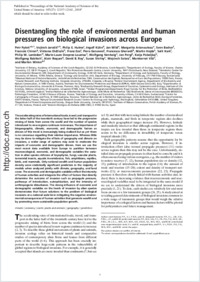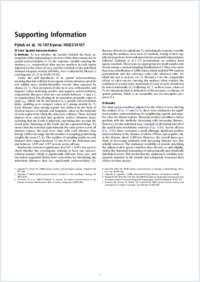Disentangling the role of environmental and human pressures on biological invasions across Europe
- Pyšek, Petr Institute of Botany, Academy of Sciences of the Czech Republic, Průhonice, Czech Republic - Department of Ecology, Faculty of Science, Charles University, Prague 2, Czech Republic
- Jarošík, Vojtěch Institute of Botany, Academy of Sciences of the Czech Republic, Průhonice, Czech Republic - Department of Ecology, Faculty of Science, Charles University, Prague 2, Czech Republic
- Hulme, Philip E. Bio-Protection Research Centre, Lincoln University, Christchurch, New Zealand
- Kühn, Ingolf Helmholtz Centre for Environmental Research–UFZ, Department of Community Ecology, Halle, Germany
- Wild, Jan Institute of Botany, Academy of Sciences of the Czech Republic, Průhonice, Czech Republic
- Arianoutsou, Margarita Department of Ecology and Systematics, Faculty of Biology, University of Athens, Greece
- Bacher, Sven Ecology and Evolution Unit, Department of Biology, University of Fribourg, Switzerland
- Chiron, Francois Muséum National d'Histoire Naturelle, Unité Mixte de Recherches 7204, Paris, France
- Didžiulis, Viktoras Coastal Research and Planning Institute, Klaipeda University, Klaipeda, Lithuania
- Essl, Franz Federal Environment Agency, Department of Biodiversity and Nature Conservation, Vienna, Austria
- Genovesi, Piero Institute for Environmental Protection and Research (ISPRA), Ozzano Emilia BO, Italy
- Gherardi, Francesca Dipartimento di Biologia Evoluzionistica, Università di Firenze, Italy
- Hejda, Martin Institute of Botany, Academy of Sciences of the Czech Republic, Průhonice, Czech Republic
- Kark, Salit Biodiversity Research Group, Department of Evolution, Systematics and Ecology, Hebrew University of Jerusalem, Israel
- Lambdon, Philip W. Global Programmes Department, Royal Society for the Protection of Birds, Bedfordshire SG19 2DL, United Kingdom
- Desprez-Loustau, Marie-Laure Institut National de la Recherche Agronomique, Unité Mixte de Recherches 120, Villenave d'Ornon, France
- Nentwig, Wolfgang Institute of Ecology and Evolution, University of Bern, Switzerland
- Pergl, Jan Institute of Botany, Academy of Sciences of the Czech Republic, Průhonice, Czech Republic
- Poboljšaj, Katja Centre for Cartography of Fauna and Flora, Ljubljana, Slovenia
- Rabitsch, Wolfgang Federal Environment Agency, Department of Biodiversity and Nature Conservation, Vienna, Austria
- Roques, Alain Institut National de la Recherche Agronomique, Unité de Recherches 0633, Orléans, France
- Roy, David B. Natural Environment Research Council Centre for Ecology and Hydrology, Wallingford, United Kingdom
- Shirley, Susan Department of Forest Ecosystems and Society, Oregon State University, Corvallis, USA
- Solarz, Wojciech Institute of Nature Conservation, Polish Academy of Sciences, Krakow, Poland
- Vilà, Montserrat Estación Biológica de Doñana, Sevilla, Spain
- Winter, Marten Helmholtz Centre for Environmental Research–UFZ, Department of Community Ecology, Halle, Germany - Ecology and Evolution Unit, Department of Biology, University of Fribourg, Switzerland
-
06.07.2010
Published in:
- Proceedings of the National Academy of Sciences of the United States of America. - 2010, vol. 107, no. 27, p. 12157-12162
English
The accelerating rates of international trade, travel, and transport in the latter half of the twentieth century have led to the progressive mixing of biota from across the world and the number of species introduced to new regions continues to increase. The importance of biogeographic, climatic, economic, and demographic factors as drivers of this trend is increasingly being realized but as yet there is no consensus regarding their relative importance. Whereas little may be done to mitigate the effects of geography and climate on invasions, a wider range of options may exist to moderate the impacts of economic and demographic drivers. Here we use the most recent data available from Europe to partition between macroecological, economic, and demographic variables the variation in alien species richness of bryophytes, fungi, vascular plants, terrestrial insects, aquatic invertebrates, fish, amphibians, reptiles, birds, and mammals. Only national wealth and human population density were statistically significant predictors in the majority of models when analyzed jointly with climate, geography, and land cover. The economic and demographic variables reflect the intensity of human activities and integrate the effect of factors that directly determine the outcome of invasion such as propagule pressure, pathways of introduction, eutrophication, and the intensity of anthropogenic disturbance. The strong influence of economic and demographic variables on the levels of invasion by alien species demonstrates that future solutions to the problem of biological invasions at a national scale lie in mitigating the negative environmental consequences of human activities that generate wealth and by promoting more sustainable population growth.
- Faculty
- Faculté des sciences et de médecine
- Department
- Département de Biologie
- Language
-
- English
- Classification
- Biological sciences
- License
- License undefined
- Identifiers
-
- RERO DOC 20322
- DOI 10.1073/pnas.1002314107
- Persistent URL
- https://folia.unifr.ch/unifr/documents/301697
Other files
Statistics
Document views: 134
File downloads:
- win_dre.pdf: 245
- win_dre_sm.pdf: 101

